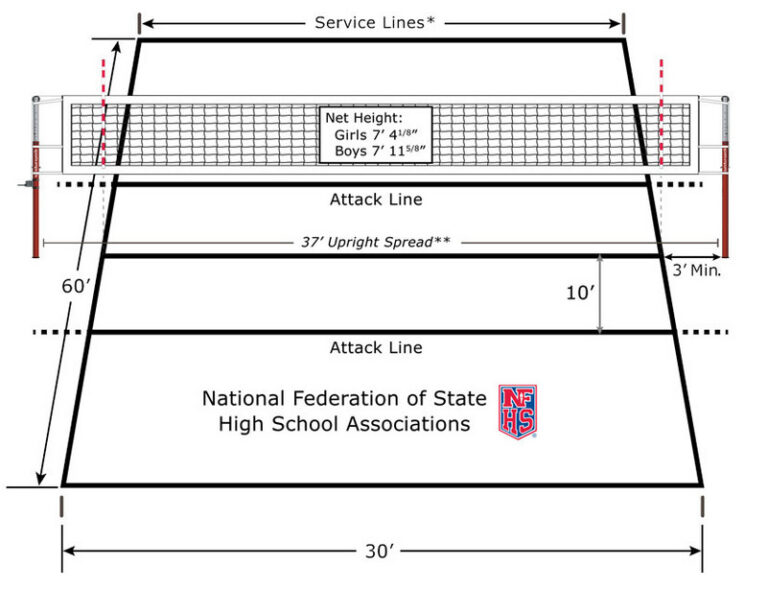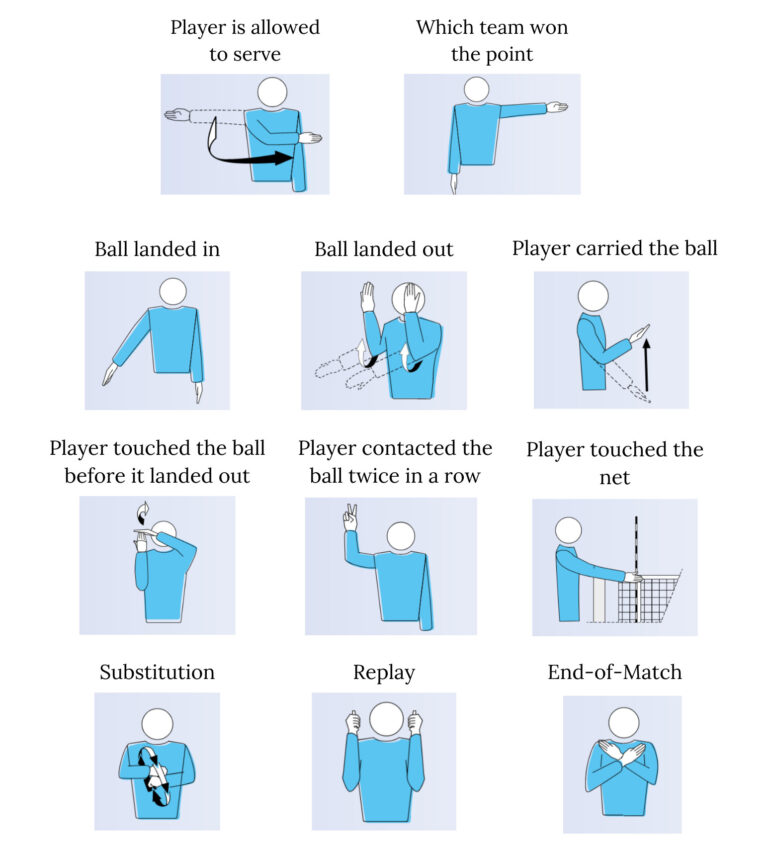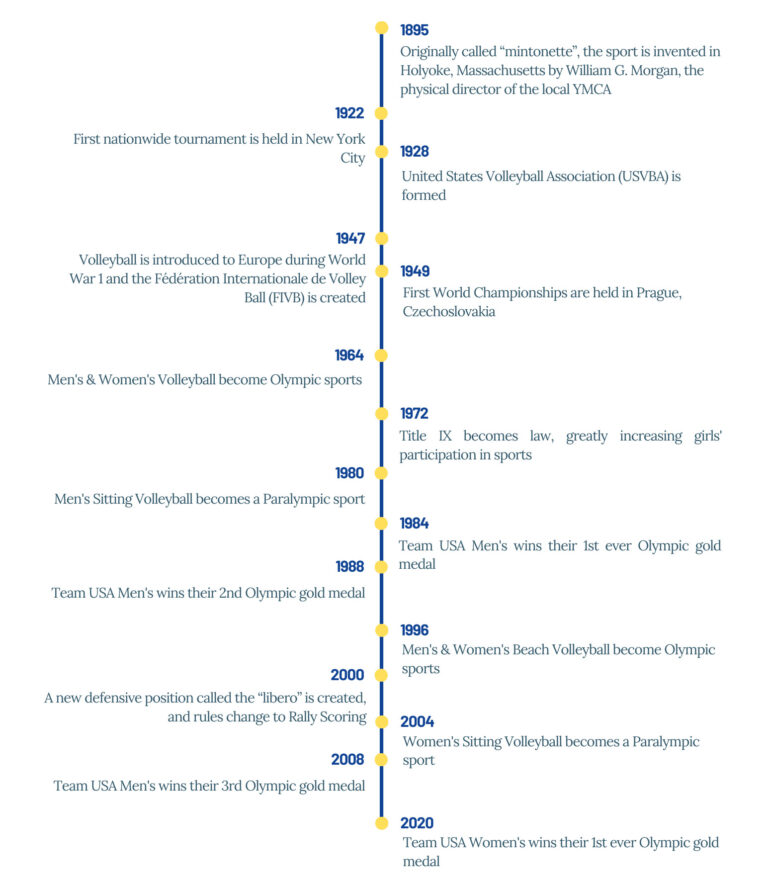Volleyball 101: Rules, Positions, Referee Signals, & More
Welcome to our Volleyball 101 page! Whether you are an involved parent, novice player, or a new coach, this comprehensive guide is designed to raise your volleyball I.Q. and answer any questions you have about the sport.
THE VOLLEYBALL COURT

- Indoor volleyball court = 30′ x 60′ (slight variation in size between high school and college, club, international, etc.)
- Two teams of six players, separated by a net down the middle of a court
- The side lines and back line are part of the court (the ball is “in” if it hits any part of a line)
Indoor Volleyball Net Heights
- Boys/Men’s = 7′ 11 ⅝”
- Girls/Women’s = 7′ 4 ⅛”
- U12 = 7’
- Girl’s U10 = 6′ 6″
RULES OF PLAY
RALLYING
- Each play/rally starts with a serve from behind a back line
- Each team has up to three touches to return the ball across the net
- The ball must cross the net between the two antennae
- If the ball hits any part of an antenna, it is “out”
- The play ends when the ball is grounded or when a player commits an error
SCORING
- Players score points by:
- grounding the ball inside the other team’s court
- causing the other team to be unable to return the ball, or
- forcing the other team to commit an error
- After each play, one team gets a point and is the serving team for the next rally (called Rally Scoring)
- Players score points by:
ROTATIONS
- Players are put into a starting lineup – three players in the front row, three in the back row
- Players must be in this specific rotational order every time before the ball is served
- After the serve is contacted, players can go anywhere on the court
- Players rotate their starting position on the court in a clock-wise direction every time their team sides-out (wins the point when the other team served)
- Throughout a game, players will start in six different locations, and will be in the front row for half the time and in the back row for the other half
- There are no “set” starting position on the court – players must relationally be in the specific order
MATCHES
- Matches can be 2 sets, or best of 3 or 5 games
- Games usually go to 25 point
- Games sometimes go to 25 points, but start at 4
- Final sets usually go to 15 points
- Teams must win by 2 points
- Scoring may be capped at a specific number
- Matches can be 2 sets, or best of 3 or 5 games
POSITIONS
Defender
Positions: Libero, Defensive specialist
Responsibilities: 1st ball contact
- Serve receive
- Defense; keep the ball off the ground
Setter
Positions: Setter
Responsibilities: 2nd ball contact
- Responsible for taking (or giving up) the second contact
- Consistent and accurate sets to hitters
Hitter
Positions: Outside hitter, Middle hitter, Right side hitter
Responsibilities: 3rd ball contact
- Get kills
- Do not commit errors
- Blocking
THE LIBERO
- aka: “The Player in the Different Colored Jersey”
- Either pronunciation is fine: “li-ber-o” vs. “lee-ber-o”
- Teams are allowed a limited number of substitutions per game
- Liberos are allowed to “go in” for any back row player and it does not count as a substitution
- Only player who can switch back in for the libero is the player who they went in for
- Teams are allowed up to two liberos but both cannot be on the court at the same time
- Special libero rules
- May not contact the ball over the net if the ball is completely above the plane of the net
- While in front of the 10’ line, they cannot overhand set a ball that is then contacted by another player above the height of the net and hit over the net
- Must enter and leave the court between the back line and the 10’ line
- Cannot play in the front row
- Can serve for only one person per set
REFEREE SIGNALS

COMMON ERRORS
Double Contact
- A player contacts the ball twice in a row.
Lift/Carry
- A player has prolonged contact with the ball, lifting or carrying it in the air
Four Contacts
- A team contacts the ball four times
Foot Fault
- A player steps onto the court when they contact the ball to serve
Net Violation
- Net violations rules vary by high school, club, and college – broadly, players may touch the net as long as it does not interfere with the play
Center Line Violation
- Center line violations vary by high school, club, and college – broadly, a player can touch the opponent’s court with hands or feet only if some part is on or above the center line.
Out of Rotation
- A team is not in their correct order/rotation when the server contacts the ball
TERMINOLOGY
Ace
- A serve that results directly in a point, either when the ball hits the floor on the receiving team’s side of the court untouched, or when it is touched but unable to be kept in play by the receiving team
Kill
- A successful hit that results in an immediate point, either by grounding the ball or causing the other team to make an error
Dig
- Passing an attacked volleyball (hit or tip)
Float Serve
- A serve with no spin on the ball, causing it to move erratically (like a knuckleball)
Side Out
- When the serving team loses the point, causing the other team to rotate clockwise and serve to start the next point
In-System
- The first contact is good enough that a team is able to run a faster tempo play
Out-of-System
- A team’s first contact is off the net and the team is unable to set certain hitters or run a faster tempo play
Free Ball
- A team is sending over the ball with a forearm pass, usually not aggressively
Down Ball
- A team is sending over the ball with a swing but the player staying on the ground
Attack Line
- Also called the “10-foot line,” this marks where a back row player must jump behind in order to contact a ball that is above the height of the net
MISCELLANEOUS
-
- A back row player must jump from behind the 10′ line if:
-
- they contact the ball over the net
- when the ball is completely above the plane of the net
-
- It is legal to contact the ball with any part of your body
- It is illegal to block or attack a serve in front of the 10′ line
- A block is not considered a touch
- Yellow card = an official warning that gets marked on the scoresheet
- Red card = the other team gets the serve and a point
- The Up Ref is in charge of the match – the down ref, work team, and line judges are there to help them
- Down ref is not allowed to stop play to call violations except for net and center line violations
- Server can only make contact with one hand
- A back row player must jump from behind the 10′ line if:
VOLLEYBALL HISTORY

OLYMPICS – TEAM USA
Men’s
- Gold Medals in 1984, 1988, and 2008
- Bronze Medals in 1992 and 2016
Women’s
- Gold Medal in 2020
- Silver Medals in 1984, 2008, and 2012
- Bronze Medals in 1992 and 2016
